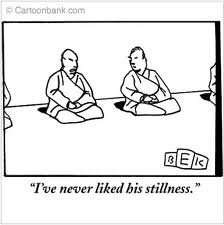W e’ve been settling into Portland, ME, since our move here in July. For one thing, Bodhi sure looks comfortable on my zafu, no?
e’ve been settling into Portland, ME, since our move here in July. For one thing, Bodhi sure looks comfortable on my zafu, no?
For another, people don’t sound as “different” as they did when we moved. Heck, the other day I called my old health insurance company in Minneapolis and talked to a nice lady there about an issue that I was having. OMG, did she have a Fargo accent! We don’t talk like that around here, that’s for gall darn sure!
Anyway, we’ve also been settling into the last few weeks of a twelve-week practice period through the Vine of Obstacles: Online Support for Zen Training and a number of issues have come up that seem right on point for Zen in general these days. Not all of these came up directly in the practice period, btw, just some of them, although Tetsugan and I have been talking about all of them (click here).
I’ve boiled it down to a top ten list for you, arranged mostly in order of what I have the most to off-gas about today.
You might notice that there’s only nine. That might be another issue – Zen can’t count vs. Zen can’t count.
And, btw, although I use “vs.” for each pair of the top (nine or) ten, most of them really are not one or the other, more a question of emphasis.
1. Realization vs. Mindfulness
This may be the biggest one for Western Zen. To what extent do we make realizing the fundamental front and center and to what extent do we go with the flow of the current popularity of “mindfulness?” Daido Loori Roshi used to frame this as “ground of being” vs. “well being.”
On this point, I favor the first and not so much the later. There are, afterall, lots of good ways to work on well being so we don’t really need the buddhadharma for that. See a therapist. Get a massage. Join a book club.
Yeah, you might say, but realization and mindfulness are not really different. The Buddha, for example, said in the Satipatthana Sutta, “If anyone should develop these four foundations of mindfulness in such a way for seven days, one of two fruits could be expected: either final knowledge here and now, or if there is a trace of clinging left, non-return.”
I’d say, well, now that’s pretty darn nice.
And I’d wonder what “in such a way” means in this context. Does it mean mindfully doing your over-the-top life to maximize your efficiency and corporate profits while relaxing your shoulders?
Nah. Probably not what the old Buddha had in mind.
Must refer to the contemplating the body in the body, feelings in the feelings, etc., with intense focus and not so much the mindfulness of a separate subject contemplating a separate object like much of mindfulness these days seems to be about.
Yeah. More like “lock yourself in a closet and sit wholeheartedly” as in the example of Yamanashi-san as told by Hakuin in Poison Blossoms From a Thicket of Thorn.
2. Aging white guys vs. everyone else
This one could have been three, “Boomers vs. millenials,” “Men vs. Women,” and “Euros vs. everyone else.”
Zen is doing fine in the boomer white guy category but not so well with younger folks, women and people of color.
Let’s look at age first. In a forum thread on diversity in the Vine of Obstacles, the following two comments were made that represent what the younger people were saying:
“I feel like there’s a pretty giant cultural misunderstanding about Zen practice specifically that is particularly unappealing to younger people – the image of blissfulness, peace, serenity – and it feels very declawed. The handful of people my age I’ve discussed my practice with almost all seem to assume it’s some combination of Stoicism and being a Krishna.”
and
“I think one of the primary problems with young people and zen is that young people are not even sure what the hell zen is. With the current cultural appropriation of the term to mean peace, bliss, compassion, etc., I think most young people either think of it as a certain aesthetic style or some kind of weekend getaway spa treatment where we all bliss out and smile at each other. After I came back from a sesshin once, people at worked were shocked when I said it was difficult. They assumed I was gone for the week getting massages and seaweed wraps with slices of cucumber on my eyes and in my water. Also, there seems to be confusion since so many zen centers offer retreats on voice dialogue, non-violent communication, and other psychology offerings. It seems that zen is about personal well-being but maybe not much else. I realize that’s interesting for a certain demographic and helps to pay the bills, but that’s not really a concern for lots of youngish people. Not to mention all the old hippies, occasional tie-dye, new age stickers, wicca stickers, diversity stickers, stickers with crosses and stars of David and crescent moons and yin-yangs…it just sometimes seem like a mish-mash of countercultural nonsense with no clear message.
“I think this ties into the main problem, which seems common in liberal christian churches i’ve visited as well. It’s the middle-class, white, liberal viewpoint that took over the formerly countercultural streams of religion. The view that all viewpoints are valid and need to be respected. The view that when I walk into a zendo and bow to Buddha, I’m not really bowing to Buddha, but rather my own inherent wisdom, or just whatever I feel comfortable bowing to. If that’s true, then why go to a zen center? I can get that just by listening to NPR and hanging out at a hip coffeeshop.
“And finally, I think that there are very few opportunities to interact with someone that is awake. Without a model for why you would want to follow the path, then what’s to ever get you started?”
Both of those young white guys said a lot, don’t you think?
And then there’s the gender gap. In most Zen places, men outnumber women by about 2:1, although there are about the same number of men and women teachers. Groups with women teachers tend to have more women but not always. How can we clarify the message of Zen and even (gasp!) change the teaching style to connect with more women who might become Zen students?
And then there’s the people of color gap. A Unitarian Universalist minister I know once joked that when the Unitarians meet to talk about diversity, it’s about different colored Prius in the parking lot.
Even more so in Zen.
Again, how can we clarify the message of Zen and even (double gasp!!) change the teaching style to connect with more people of color who might become Zen students?
3. Thorough-going training vs. spiritual by-passing
As we’ve gone along and drifted more to householder training (see below in #8), along with all its virtues, the baseline for training has dropped and we’ve failed to deal fully with spiritual by-passing. It’s much easier to have a distant relationship with a teacher and community and have the dogma of Zen without really digging into our issues. Robert Masters calls this “Liking the light while avoiding the heat.”
4. Purpose vs. feeling
In our feeling-centered culture, we tend to forget our purpose and get tossed away by fickle feelings. I like Leonard on this point (and many more): “I don’t trust my inner feelings, inner feelings come and go.”
Sticking with our purpose through the arising and passing of all the many feelings, is a vital skill for our practice-enlightenment projects.
This one is tricky, especially in light of #3. Dismissing our feelings is a big piece of spiritual by-passing. The key point: there’s a big difference between knowing our feelings and sticking with our purpose, the heart’s innermost request, and denying our feelings in order to prop up a spiritualized ego.
5. Ethical investigation vs. moralistic judgements
Living a life of ethical investigation is essential to actualizing the great matter. And yet. What I see in the online forums with a “Zen” handle and what I often hear from practitioners (especially when the going gets tough), dips way into using the precepts and buddhadharma in general to beat people up. You know, “those people” who have messed up. Kinda fun, I suppose, but kinda stuck on feelings that, yes, do come and go. With ethical investigation, we turn the light and look at ourselves and not make a project of others and their issues – although they’re undoubtedly messed up too.
6. Public vs. private understanding
Our culture is crazy about “my way” everything, including spirituality where the point is to be free from the yoke and chains of swirling affective preferences. That’s especially true of Zen.
Chung-feng Ming-pen said this about the word “koan:”
“The word kung (ko), or “public,” means that the koans put a stop to private understanding; the word an (an), or “case records,” means that they are guaranteed to accord with the buddhas and ancestors.”
If those in the buddhadharma don’t take a clear stand on this point, Zen will eventually become so watered down (see #2), that it might as well go down with the next flush.
“My Way” spirituality is antithetical to the buddhadharma.
7. In-person vs. online
In my view, the most effective training models in the future will integrate the use of online technologies and in-person practice. Again, see Vine of Obstacles: Online Support for Zen Training if you’re interested in learning more about how we’re doing this.
8. Monastic vs. householder training
Do Zen priests need real monastic time? Or is training in the world just as good? Most Zen priests, after all, work primarily with practitioners engaged in the world and are themselves leading pretty worldly lives. Me included.
Still, imv, the simple answer for the just-sitting lines, is “yes.” The monastic metaphor is at the heart of the just-sitting tradition and for a priest to facilitate the lay practitioner in bringing the awakening of this tradition alive in lay life, then direct and personal experience with monastic practice is a necessary condition. How much monastic practice is sufficient is another question – but I suspect measurement in terms of number of ango or years is not the most reliable way to access (although it is the easiest).
9. Koan vs. shikantaza
I’ve already written a lot about this and annoyed some people too (so I’ve tucked this one away at the bottom). I’ll just refer you to my latest on this: Dogen and Koan: The Ultimate Truly Definitive Unquestionable Smoking Gun.
The main point is this – they’re not two.
And that’s the list for today.
Comments welcome.











